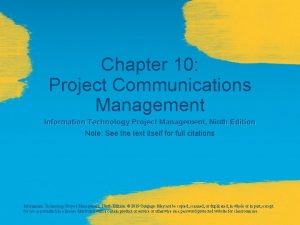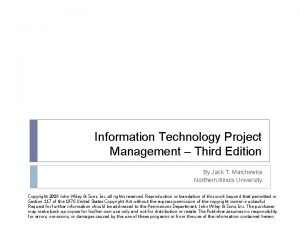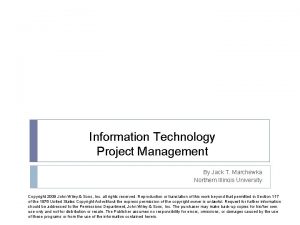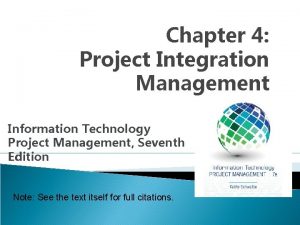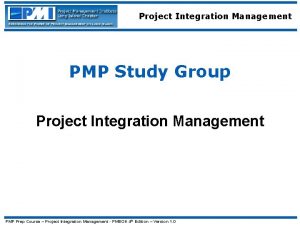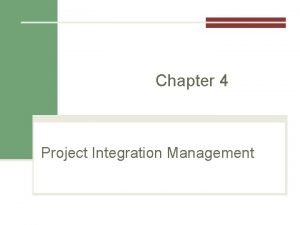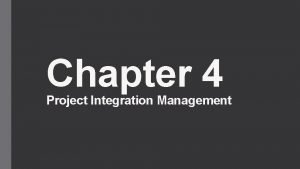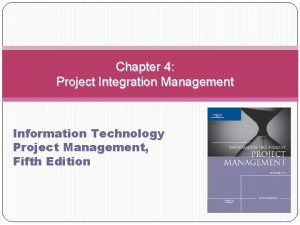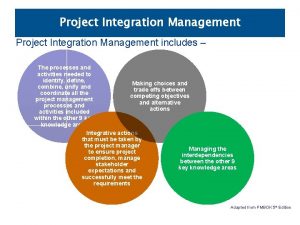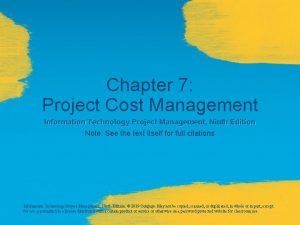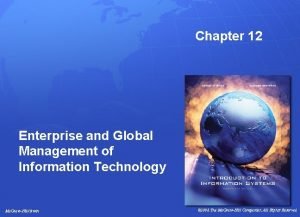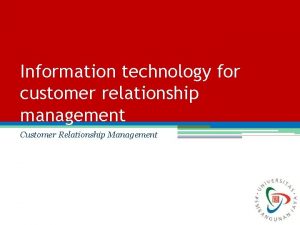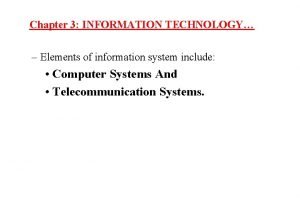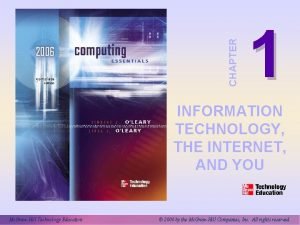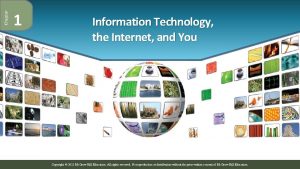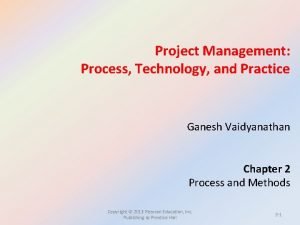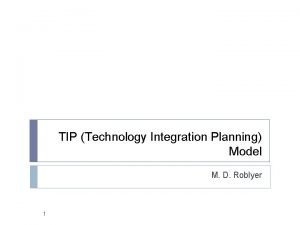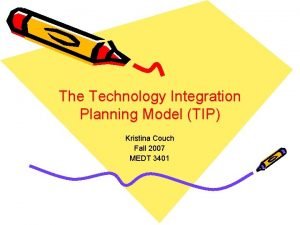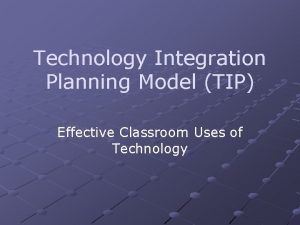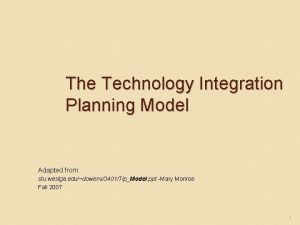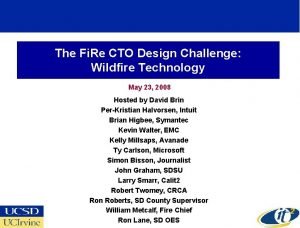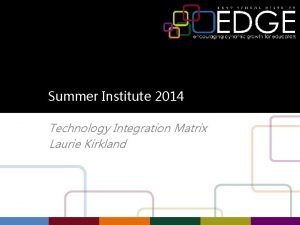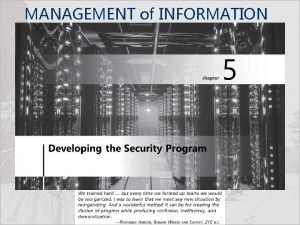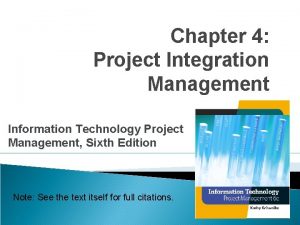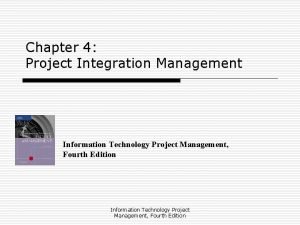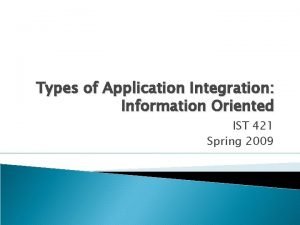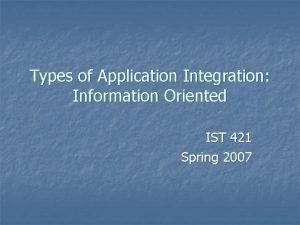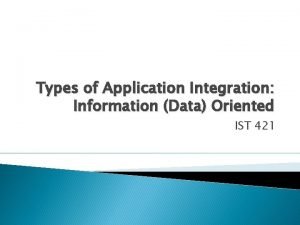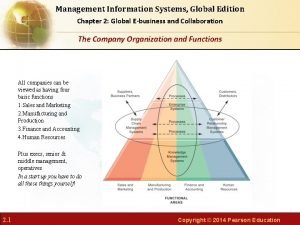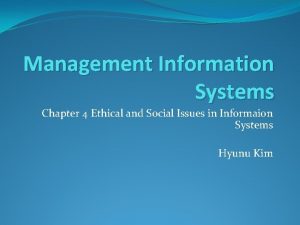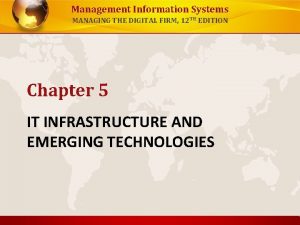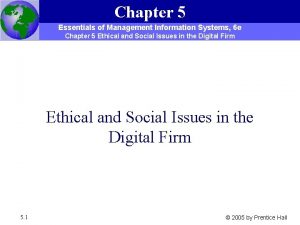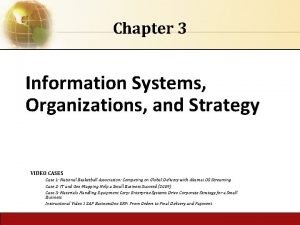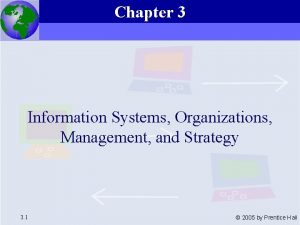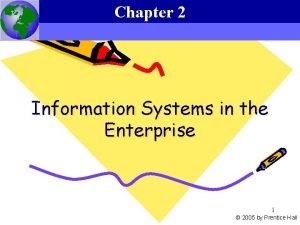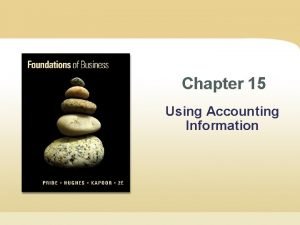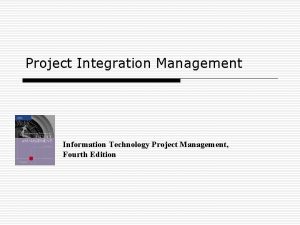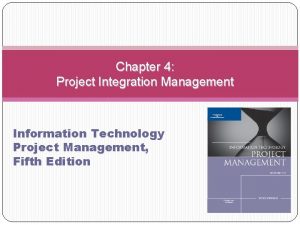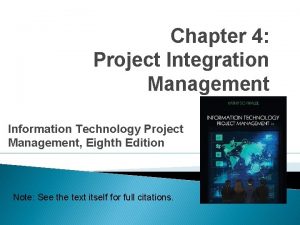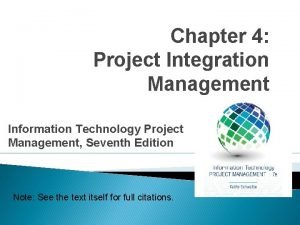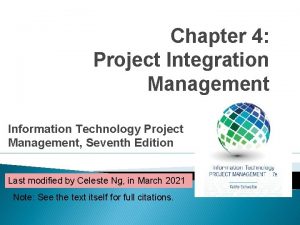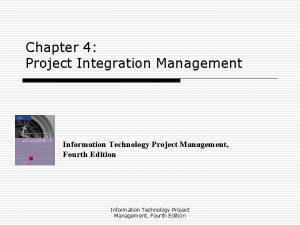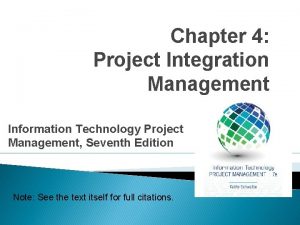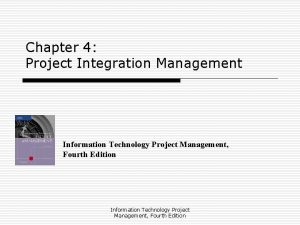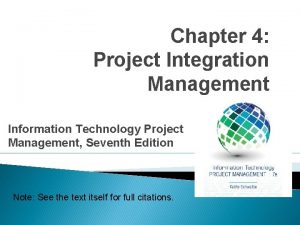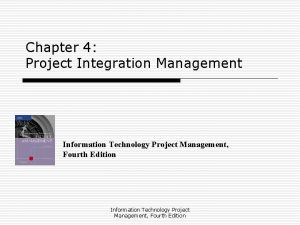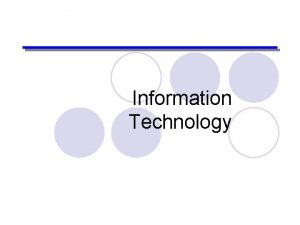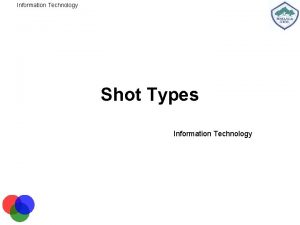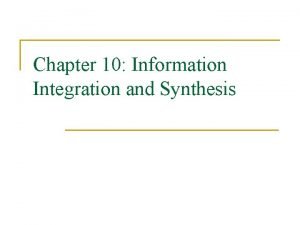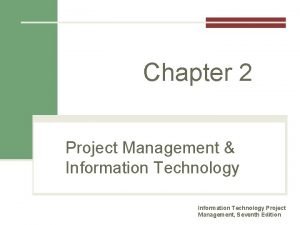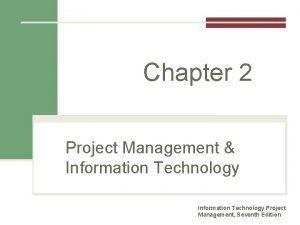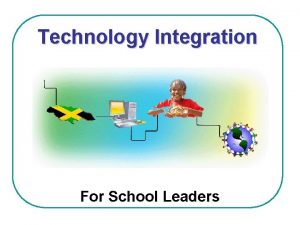Chapter 4 Project Integration Management Information Technology Project


















































- Slides: 50

Chapter 4: Project Integration Management Information Technology Project Management, Eighth Edition Note: See the text itself for full citations. Information Technology Project Management, Ninth Edition. © 2019 Cengage. May not be copied, scanned, or duplicated, in whole or in part, except for use as permitted in a license distributed with a certain product or service or otherwise on a password-protected website for classroom use.

Learning Objectives (1 of 2) • Describe an overall framework for project integration management as it relates to the other project management knowledge areas and the project life cycle • Discuss the strategic planning process and apply different project selection methods • Explain the importance of creating a project charter to formally initiate projects • Describe project management plan development, understand the content of these plans, and describe approaches for creating them • Explain project execution, its relationship to project planning, the factors related to successful results, and tools and techniques to assist in directing and managing project work Information Technology Project Management, Ninth Edition. © 2019 Cengage. May not be copied, scanned, or duplicated, in whole or in part, except for use as permitted in a license distributed with a certain product or service or otherwise on a password-protected website for classroom use.

Learning Objectives (2 of 2) • Apply the principles of knowledge management to the various aspects of project integration • Describe the process of monitoring and controlling a project • Define the integrated change control process, relate this to the steps for planning for and managing changes on information technology (IT) projects, and create an appropriate change control system for a project that incorporates both • Explain the importance of developing and following good procedures for closing projects • Describe how software can assist in project integration management • Discuss considerations for agile/adaptive environments Information Technology Project Management, Ninth Edition. © 2019 Cengage. May not be copied, scanned, or duplicated, in whole or in part, except for use as permitted in a license distributed with a certain product or service or otherwise on a password-protected website for classroom use.

What is Project Integration Management? (1 of 3) • Project managers must coordinate all of the other knowledge areas throughout a project’s life cycle • Many new project managers have trouble looking at the “big picture” and want to focus on too many details (See opening case for a real example) • Project integration management is not the same thing as software integration Information Technology Project Management, Ninth Edition. © 2019 Cengage. May not be copied, scanned, or duplicated, in whole or in part, except for use as permitted in a license distributed with a certain product or service or otherwise on a password-protected website for classroom use.

What is Project Integration Management? (2 of 3) • Main processes • • • Developing the project charter Developing the project management plan Directing and managing project work Monitoring and controlling project work Performing integrated change control Closing the project or phase Information Technology Project Management, Ninth Edition. © 2019 Cengage. May not be copied, scanned, or duplicated, in whole or in part, except for use as permitted in a license distributed with a certain product or service or otherwise on a password-protected website for classroom use.

What is Project Integration Management? (3 of 3) Information Technology Project Management, Ninth Edition. © 2019 Cengage. May not be copied, scanned, or duplicated, in whole or in part, except for use as permitted in a license distributed with a certain product or service or otherwise on a password-protected website for classroom use.

What Went Wrong? • Making sure people are paid is crucial to employee satisfaction • When a payroll system project doesn’t work, it is a disaster • Phoenix system project goal: reduce payroll processing overhead and staffing costs • One of the worst government-managed IT implementations ever • Civil servants paid through the system have been underpaid, overpaid, or not paid at all since its rollout began Information Technology Project Management, Ninth Edition. © 2019 Cengage. May not be copied, scanned, or duplicated, in whole or in part, except for use as permitted in a license distributed with a certain product or service or otherwise on a password-protected website for classroom use.

Strategic Planning and Project Selection (1 of 3) • Strategic planning involves determining long-term objectives • • Analyzing the strengths and weaknesses of an organization Studying opportunities and threats in the business environment Predicting future trends Projecting the need for new products and services • SWOT analysis • Strengths, Weaknesses, Opportunities, and Threats • Identifying potential projects • Start of project initiation • Aligning IT with business strategy • Organization must develop a strategy for using IT to define how it will support the organization’s objectives Information Technology Project Management, Ninth Edition. © 2019 Cengage. May not be copied, scanned, or duplicated, in whole or in part, except for use as permitted in a license distributed with a certain product or service or otherwise on a password-protected website for classroom use.

Strategic Planning and Project Selection (2 of 3) Information Technology Project Management, Ninth Edition. © 2019 Cengage. May not be copied, scanned, or duplicated, in whole or in part, except for use as permitted in a license distributed with a certain product or service or otherwise on a password-protected website for classroom use.

Strategic Planning and Project Selection (3 of 3) Information Technology Project Management, Ninth Edition. © 2019 Cengage. May not be copied, scanned, or duplicated, in whole or in part, except for use as permitted in a license distributed with a certain product or service or otherwise on a password-protected website for classroom use.

Best Practice • In 2017 Fortune released their Business by Design list, highlighting the 24 companies they believe are using technology and globalization to find their competitive advantage • • Apple: great design and learning to ‘think different’ Dyson: robotics and artificial intelligence research Samsung: budget brand Capital One: reinvented itself as a software company and innovation incubator Information Technology Project Management, Ninth Edition. © 2019 Cengage. May not be copied, scanned, or duplicated, in whole or in part, except for use as permitted in a license distributed with a certain product or service or otherwise on a password-protected website for classroom use.

Methods for Selecting Projects • Potential projects must be narrowed down • Methods for selecting projects • • • Focusing on broad organizational needs Categorizing information technology projects Performing net present value or other financial analyses Using a weighted scoring model Implementing a balanced scorecard Information Technology Project Management, Ninth Edition. © 2019 Cengage. May not be copied, scanned, or duplicated, in whole or in part, except for use as permitted in a license distributed with a certain product or service or otherwise on a password-protected website for classroom use.

Focusing on Broad Organizational Needs • Projects that address broad organizational needs are much more likely to be successful because they will be important to the organization • Examples: improve safety or increase morale • Important criteria for selecting projects • Need • Funding • Will Information Technology Project Management, Ninth Edition. © 2019 Cengage. May not be copied, scanned, or duplicated, in whole or in part, except for use as permitted in a license distributed with a certain product or service or otherwise on a password-protected website for classroom use.

Categorizing IT Projects • Categorizations • Respond to a problem, opportunity, or directive • How long it will take to do and when it is needed • Overall priority of the project Information Technology Project Management, Ninth Edition. © 2019 Cengage. May not be copied, scanned, or duplicated, in whole or in part, except for use as permitted in a license distributed with a certain product or service or otherwise on a password-protected website for classroom use.

Performing Financial Analyses • Financial considerations are often an important consideration in selecting projects • Regardless of current economics • Primary methods for determining the projected financial value of projects • Net present value (NPV) analysis • Return on investment (ROI) • Payback analysis Information Technology Project Management, Ninth Edition. © 2019 Cengage. May not be copied, scanned, or duplicated, in whole or in part, except for use as permitted in a license distributed with a certain product or service or otherwise on a password-protected website for classroom use.

Net Present Value Analysis (1 of 4) • Method of calculating the expected net monetary gain or loss from a project by discounting all expected future cash inflows and outflows to the present point in time • Projects with a positive NPV should be considered if financial value is a key criterion • Projects with higher NPVs are preferred Information Technology Project Management, Ninth Edition. © 2019 Cengage. May not be copied, scanned, or duplicated, in whole or in part, except for use as permitted in a license distributed with a certain product or service or otherwise on a password-protected website for classroom use.

Net Present Value Analysis (2 of 4) Information Technology Project Management, Ninth Edition. © 2019 Cengage. May not be copied, scanned, or duplicated, in whole or in part, except for use as permitted in a license distributed with a certain product or service or otherwise on a password-protected website for classroom use.

Net Present Value Analysis (3 of 4) Information Technology Project Management, Ninth Edition. © 2019 Cengage. May not be copied, scanned, or duplicated, in whole or in part, except for use as permitted in a license distributed with a certain product or service or otherwise on a password-protected website for classroom use.

Net Present Value Analysis (4 of 4) • NPV calculations • Determine estimated costs and benefits for the life of the project and the products it produces • Determine the discount rate • Calculate the net present value • Important considerations • Some organizations refer to the investment year or years for project costs as Year 0 and do not discount costs in Year 0 • Discount rate can vary, often based on the prime rate and other economic considerations • Costs can be entered as negative numbers and can be listed first (and then benefits) Information Technology Project Management, Ninth Edition. © 2019 Cengage. May not be copied, scanned, or duplicated, in whole or in part, except for use as permitted in a license distributed with a certain product or service or otherwise on a password-protected website for classroom use.

Return on Investment • Calculated by subtracting the project costs from the benefits and then dividing by the costs • ROI = (total discounted benefits - total discounted costs) / discounted costs • The higher the ROI, the better • Many organizations have a required rate of return • Minimum acceptable rate of return on investment for projects • Internal rate of return (IRR) can by calculated by finding the discount rate that makes the NPV equal to zero Information Technology Project Management, Ninth Edition. © 2019 Cengage. May not be copied, scanned, or duplicated, in whole or in part, except for use as permitted in a license distributed with a certain product or service or otherwise on a password-protected website for classroom use.

Payback Analysis (1 of 2) • Payback period is the amount of time it will take to recoup, in the form of net cash inflows, the total dollars invested in a project • Determines how much time will elapse before accrued benefits overtake accrued and continuing costs • Payback occurs when the net cumulative discounted benefits equals the costs • Many organizations have requirements for the length of the payback period of an investment Information Technology Project Management, Ninth Edition. © 2019 Cengage. May not be copied, scanned, or duplicated, in whole or in part, except for use as permitted in a license distributed with a certain product or service or otherwise on a password-protected website for classroom use.

Payback Analysis (2 of 2) Information Technology Project Management, Ninth Edition. © 2019 Cengage. May not be copied, scanned, or duplicated, in whole or in part, except for use as permitted in a license distributed with a certain product or service or otherwise on a password-protected website for classroom use.

Using a Weighted Scoring Model (1 of 2) • Provides a systematic process for selecting projects based on many criteria • • Identify criteria important to the project selection process Assign weights (percentages) to each criterion so they add up to 100% Assign scores to each criterion for each project Multiply the scores by the weights and get the total weighted scores Information Technology Project Management, Ninth Edition. © 2019 Cengage. May not be copied, scanned, or duplicated, in whole or in part, except for use as permitted in a license distributed with a certain product or service or otherwise on a password-protected website for classroom use.

Using a Weighted Scoring Model (2 of 2) Information Technology Project Management, Ninth Edition. © 2019 Cengage. May not be copied, scanned, or duplicated, in whole or in part, except for use as permitted in a license distributed with a certain product or service or otherwise on a password-protected website for classroom use.

Implementing a Balanced Scorecard • Drs. Robert Kaplan and David Norton developed this approach to help select and manage projects that align with business strategy • A balanced scorecard is a strategic planning and management system that helps organizations align business activities to strategy, improve communications, and monitor performance against strategic goals Information Technology Project Management, Ninth Edition. © 2019 Cengage. May not be copied, scanned, or duplicated, in whole or in part, except for use as permitted in a license distributed with a certain product or service or otherwise on a password-protected website for classroom use.

Developing a Project Charter (1 of 2) • After deciding what project to work on, it is important to let the rest of the organization know • A project charter is a document that formally recognizes the existence of a project and provides direction on the project’s objectives and management • Key project stakeholders should sign a project charter to acknowledge agreement on the need and intent of the project • A project charter is a key output of the initiation process Information Technology Project Management, Ninth Edition. © 2019 Cengage. May not be copied, scanned, or duplicated, in whole or in part, except for use as permitted in a license distributed with a certain product or service or otherwise on a password-protected website for classroom use.

Developing a Project Charter (2 of 2) • Inputs for developing a project charter • • • Business case Benefits management plan Agreements Enterprise environmental factors Organizational process assets Information Technology Project Management, Ninth Edition. © 2019 Cengage. May not be copied, scanned, or duplicated, in whole or in part, except for use as permitted in a license distributed with a certain product or service or otherwise on a password-protected website for classroom use.

Developing a Project Management Plan • Document used to coordinate all project planning documents and help guide a project’s execution and control • Plans created in the other knowledge areas are subsidiary parts of the overall project management plan • Common elements of a project management plan • • • Introduction/overview of the project Description of how the project is organized Management and technical processes used on the project Work to be done Schedule and budget information References to other project planning documents Information Technology Project Management, Ninth Edition. © 2019 Cengage. May not be copied, scanned, or duplicated, in whole or in part, except for use as permitted in a license distributed with a certain product or service or otherwise on a password-protected website for classroom use.

Using Guidelines to Create Project Management Plans Major Section Headings Section Topics Overview Purpose, scope, and objectives; assumptions and constraints; project deliverables; schedule and budget summary; evolution of the plan Project Organization External interfaces; internal structure; roles and responsibilities Managerial Process Plan Start-up plans (estimation, staffing, resource acquisition, and project staff training plans); work plan (work activities, schedule, resource, and budget allocation); control plan; risk management plan; closeout plan Technical Process Plans Process model; methods, tools, and techniques; infrastructure plan; product acceptance plan Supporting Process Plans Configuration management plan; verification and validation plan; documentation plan; quality assurance plan; reviews and audits; problem resolution plan; subcontractor management plan; process improvement plan . Table 4 -3 Sample contents for the IEEE software project management plan (SPMP) Source: IEEE Standard 1058– 1998 Information Technology Project Management, Ninth Edition. © 2019 Cengage. May not be copied, scanned, or duplicated, in whole or in part, except for use as permitted in a license distributed with a certain product or service or otherwise on a password-protected website for classroom use.

Directing and Managing Project Work • Involves managing and performing the work described in the project management plan • The majority of time and money is usually spent on execution • The application area of the project directly affects project execution • Products of the project are produced during the execution phase • The project manager needs to focus on leading the project team and managing stakeholder relationships to execute the project management plan successfully • Project resource management, communications management, and stakeholder management are crucial to a project’s success Information Technology Project Management, Ninth Edition. © 2019 Cengage. May not be copied, scanned, or duplicated, in whole or in part, except for use as permitted in a license distributed with a certain product or service or otherwise on a password-protected website for classroom use.

Coordinating Planning and Execution • Project planning and execution are intertwined and inseparable activities • The main function of creating a project management plan is to guide project execution • Those who will do the work should help to plan the work • All project personnel need to develop both planning and executing skills, and they need experience in these areas Information Technology Project Management, Ninth Edition. © 2019 Cengage. May not be copied, scanned, or duplicated, in whole or in part, except for use as permitted in a license distributed with a certain product or service or otherwise on a password-protected website for classroom use.

Providing Strong Leadership and a Supportive Culture • Project managers must lead by example • Demonstrate the importance of creating and then following good project plans and following them in project execution • Organizational culture can help project execution • Providing guidelines and templates • Tracking performance based on plans • Project managers may still need to break the rules to meet project goals • Senior managers must support those actions Information Technology Project Management, Ninth Edition. © 2019 Cengage. May not be copied, scanned, or duplicated, in whole or in part, except for use as permitted in a license distributed with a certain product or service or otherwise on a password-protected website for classroom use.

What Went Right? • 2015 PMI report found that only 12 percent of organizations were considered to be high performers • Percentage has remained unchanged • Organizations must make major cultural changes to improve • Make sure everyone fully understands the value of project management • Require executive sponsors are fully engaged on projects and programs • Align projects to the organization’s strategy Information Technology Project Management, Ninth Edition. © 2019 Cengage. May not be copied, scanned, or duplicated, in whole or in part, except for use as permitted in a license distributed with a certain product or service or otherwise on a password-protected website for classroom use.

Capitalizing on Product, Business, and Application Area Knowledge • It is often helpful for IT project managers to have prior technical experience • Small projects: the project manager may be required to perform some of the technical work or mentor team members to complete the projects • Large projects: the project manager must understand the business and application area of the project Information Technology Project Management, Ninth Edition. © 2019 Cengage. May not be copied, scanned, or duplicated, in whole or in part, except for use as permitted in a license distributed with a certain product or service or otherwise on a password-protected website for classroom use.

Project Execution Tools and Techniques • Project managers can use specific tools and techniques to perform activities that are part of execution processes • Expert judgment • Meetings • Project management information systems Information Technology Project Management, Ninth Edition. © 2019 Cengage. May not be copied, scanned, or duplicated, in whole or in part, except for use as permitted in a license distributed with a certain product or service or otherwise on a password-protected website for classroom use.

Managing Project Knowledge • Basic types of knowledge • Explicit knowledge: easily explained using words, pictures, or numbers and is easy to communicate, store, and distribute • Tacit knowledge: difficult to express and highly personal • Knowledge management should be done before, during, and after projects are completed • Often very difficult to accomplish Information Technology Project Management, Ninth Edition. © 2019 Cengage. May not be copied, scanned, or duplicated, in whole or in part, except for use as permitted in a license distributed with a certain product or service or otherwise on a password-protected website for classroom use.

Advice for Young Professionals • Many college students excel in this area based on their experiences doing rigorous coursework • To stand out in your job, consider volunteering to be in charge of creating your project team’s lessons-learned register Information Technology Project Management, Ninth Edition. © 2019 Cengage. May not be copied, scanned, or duplicated, in whole or in part, except for use as permitted in a license distributed with a certain product or service or otherwise on a password-protected website for classroom use.

Monitoring and Controlling Project Work • Changes are inevitable on most projects, so it’s important to develop and follow a process to monitor and control changes • Monitoring project work includes collecting, measuring, and disseminating performance information • The project management plan provides the baseline for identifying and controlling project changes • A baseline is a starting point, a measurement, or an observation that is documented so that it can be used for future comparison. Information Technology Project Management, Ninth Edition. © 2019 Cengage. May not be copied, scanned, or duplicated, in whole or in part, except for use as permitted in a license distributed with a certain product or service or otherwise on a password-protected website for classroom use.

Media Snapshot • The 2002 Olympic Winter Games and Paralympics took five years to plan and cost more than $1. 9 billion • PMI awarded the Salt Lake Organizing Committee (SLOC) the Project of the Year award for delivering world-class games • Four years before, the SLOC used a Primavera software-based system with a cascading color-coded WBS to integrate planning • Also used an Executive Roadmap, a one-page list of the top 100 Games-wide activities, to keep executives apprised of progress • Activities were tied to detailed project information within each department’s schedule • A 90 -day highlighter showed which managers were accountable for each integrated activity • Fraser Bullock, SLOC Chief Operating Officer and Chief, said, “We knew when we were on and off schedule and where we had to apply additional resources. The interrelation of the functions meant they could not run in isolation—it was a smoothly running machine. ”* *Foti, Ross, “The Best Winter Olympics, Period, ” PM Network (January 2004) 23 Information Technology Project Management, Ninth Edition. © 2019 Cengage. May not be copied, scanned, or duplicated, in whole or in part, except for use as permitted in a license distributed with a certain product or service or otherwise on a password-protected website for classroom use.

Performing Integrated Change Control • Main objectives • Influencing the factors that create changes to ensure that changes are beneficial • Determining that a change has occurred • Managing actual changes as they occur Information Technology Project Management, Ninth Edition. © 2019 Cengage. May not be copied, scanned, or duplicated, in whole or in part, except for use as permitted in a license distributed with a certain product or service or otherwise on a password-protected website for classroom use.

Change Control on IT Projects • Former view: the project team should strive to do exactly what was planned on time and within budget • Problem: project teams could rarely meet original project goals • Modern view: project management is a process of constant communication and negotiation • Solution: changes are often beneficial and the project team should plan for them Information Technology Project Management, Ninth Edition. © 2019 Cengage. May not be copied, scanned, or duplicated, in whole or in part, except for use as permitted in a license distributed with a certain product or service or otherwise on a password-protected website for classroom use.

Change Control System (1 of 3) • Formal, documented process that describes when and how official project documents and work may be changed • Describes who is authorized to make changes, paperwork required for these changes, and any automated or manual tracking systems the project will use • Change control board (CCB) is a formal group of people responsible for approving or rejecting changes on a project • Provide guidelines for preparing change requests, evaluate change requests, and manage the implementation of approved changes • Some CCBs only meet occasionally, so it may take too long for changes to occur • Some organizations have policies in place for time-sensitive changes Information Technology Project Management, Ninth Edition. © 2019 Cengage. May not be copied, scanned, or duplicated, in whole or in part, except for use as permitted in a license distributed with a certain product or service or otherwise on a password-protected website for classroom use.

Change Control System (2 of 3) • Configuration management ensures that the descriptions of the project’s products are correct and complete • Involves identifying and controlling the functional and physical design characteristics of products and their support documentation • Configuration management specialists identify and document configuration requirements, control changes, record and report changes, and audit the products to verify conformance to requirements Information Technology Project Management, Ninth Edition. © 2019 Cengage. May not be copied, scanned, or duplicated, in whole or in part, except for use as permitted in a license distributed with a certain product or service or otherwise on a password-protected website for classroom use.

Change Control System (3 of 3) View project management as a process of constant communication and negotiation. Plan for change. Establish a formal change control system, including a change control board (CCB) and IT steering committee. Use effective configuration management. Define procedures for making timely decisions about smaller changes. Use written and oral performance reports to help identify and manage change. Use project management software and other software to help manage and communicate changes. Focus on leading the project team and meeting overall project goals and expectations. Table 4 -4 suggestions for performing integrated change control Information Technology Project Management, Ninth Edition. © 2019 Cengage. May not be copied, scanned, or duplicated, in whole or in part, except for use as permitted in a license distributed with a certain product or service or otherwise on a password-protected website for classroom use.

Global Issues • Rapid changes in technology, such as the increased use of mobile roaming for communications, often cause governments around the world to take action • Incompatible hardware, software, and networks can make communications difficult in some regions, and a lack of competition cause prices to soar • Organisation for Economic Co-operation and Development (OECD) promotes policies that will improve the economic and social well-being of people around the world • In February 2012, the OECD called upon its members’ governments to boost competition in international mobile roaming markets • By the end of 2013, wireless broadband penetration grew to 72. 4% in the OECD area Information Technology Project Management, Ninth Edition. © 2019 Cengage. May not be copied, scanned, or duplicated, in whole or in part, except for use as permitted in a license distributed with a certain product or service or otherwise on a password-protected website for classroom use.

Closing Projects or Phases • To close a project or phase, you must finalize all activities and transfer the completed or cancelled work to the appropriate people • Main inputs are the project charter, project management plan, project documents, accepted deliverables, business documents, agreements, procurement documentation, and organizational process assets • Main tools and techniques are expert judgment, data analysis, and meetings Information Technology Project Management, Ninth Edition. © 2019 Cengage. May not be copied, scanned, or duplicated, in whole or in part, except for use as permitted in a license distributed with a certain product or service or otherwise on a password-protected website for classroom use.

Using Software to Assist in Project Integration Management (1 of 2) • Several types of software can be used to assist in project integration management • • • Documents can be created with word processing software Presentations are created with presentation software Tracking can be done with spreadsheets or databases Communication software can facilitate communications Project management software can pull everything together and show detailed and summarized information Information Technology Project Management, Ninth Edition. © 2019 Cengage. May not be copied, scanned, or duplicated, in whole or in part, except for use as permitted in a license distributed with a certain product or service or otherwise on a password-protected website for classroom use.

Using Software to Assist in Project Integration Management (2 of 2) Information Technology Project Management, Ninth Edition. © 2019 Cengage. May not be copied, scanned, or duplicated, in whole or in part, except for use as permitted in a license distributed with a certain product or service or otherwise on a password-protected website for classroom use.

Considerations for Agile/Adaptive Environments • Iterative and agile approaches promote the engagement of team members • Expectations of the project manager do not change in an adaptive environment, but control of the detailed product planning and delivery is delegated to the team • Project managers using any product life cycle should focus on creating a collaborative decision-making environment and providing opportunities for team members to develop additional skills Information Technology Project Management, Ninth Edition. © 2019 Cengage. May not be copied, scanned, or duplicated, in whole or in part, except for use as permitted in a license distributed with a certain product or service or otherwise on a password-protected website for classroom use.

Chapter Summary • Project integration management ties together all the other areas of project management • Primary focus should be on project integration management • Main processes • • Develop the project charter Create an assumption log Develop the project management plan Direct and manage project execution Manage project knowledge Monitor and control project work Perform integrated change control Close the project or phase Information Technology Project Management, Ninth Edition. © 2019 Cengage. May not be copied, scanned, or duplicated, in whole or in part, except for use as permitted in a license distributed with a certain product or service or otherwise on a password-protected website for classroom use.
 Information technology project management 9th edition
Information technology project management 9th edition Blue project chapter 5
Blue project chapter 5 Project management quality control
Project management quality control Project management chapter 6
Project management chapter 6 Information technology project management 9th edition
Information technology project management 9th edition Information technology project management
Information technology project management Information technology project management
Information technology project management What is project integration management
What is project integration management Directing and managing project execution
Directing and managing project execution Traditional project management vs modern project management
Traditional project management vs modern project management Pmp integration management
Pmp integration management Project integration management example
Project integration management example Explain project integration management
Explain project integration management Focusing on broad organizational needs
Focusing on broad organizational needs Six processes of project integration management
Six processes of project integration management Three dimensions of corporate strategy
Three dimensions of corporate strategy Vertical diversification example
Vertical diversification example Simultaneous integration example
Simultaneous integration example Information technology cost management
Information technology cost management Global management technologies
Global management technologies Information technology resource
Information technology resource Information technology and customer relationship management
Information technology and customer relationship management Information technology chapter 3
Information technology chapter 3 Chapter 1 information technology the internet and you
Chapter 1 information technology the internet and you Chapter 1 information technology the internet and you
Chapter 1 information technology the internet and you Project management process technology and practice
Project management process technology and practice Model roblyer
Model roblyer Couch integration
Couch integration Technology integration planning model
Technology integration planning model Technology integration planning model example
Technology integration planning model example Wildfire technology integration
Wildfire technology integration Laurie kirkland
Laurie kirkland Project management for information security
Project management for information security Project management information system example
Project management information system example Project management information system example
Project management information system example Information oriented application integration
Information oriented application integration Information-oriented application integration
Information-oriented application integration Information-oriented application integration
Information-oriented application integration Management information system chapter 2
Management information system chapter 2 Management information system chapter 3
Management information system chapter 3 Management information system chapter 4
Management information system chapter 4 Management information system chapter 1
Management information system chapter 1 Chapter 9 information management and security
Chapter 9 information management and security Management information system chapter 5
Management information system chapter 5 Management information system chapter 5
Management information system chapter 5 Introduction to mis
Introduction to mis Mis chapter 5
Mis chapter 5 Management information system chapter 3
Management information system chapter 3 Management information system chapter 3
Management information system chapter 3 Management information system chapter 2
Management information system chapter 2 Chapter 15 using management and accounting information
Chapter 15 using management and accounting information




